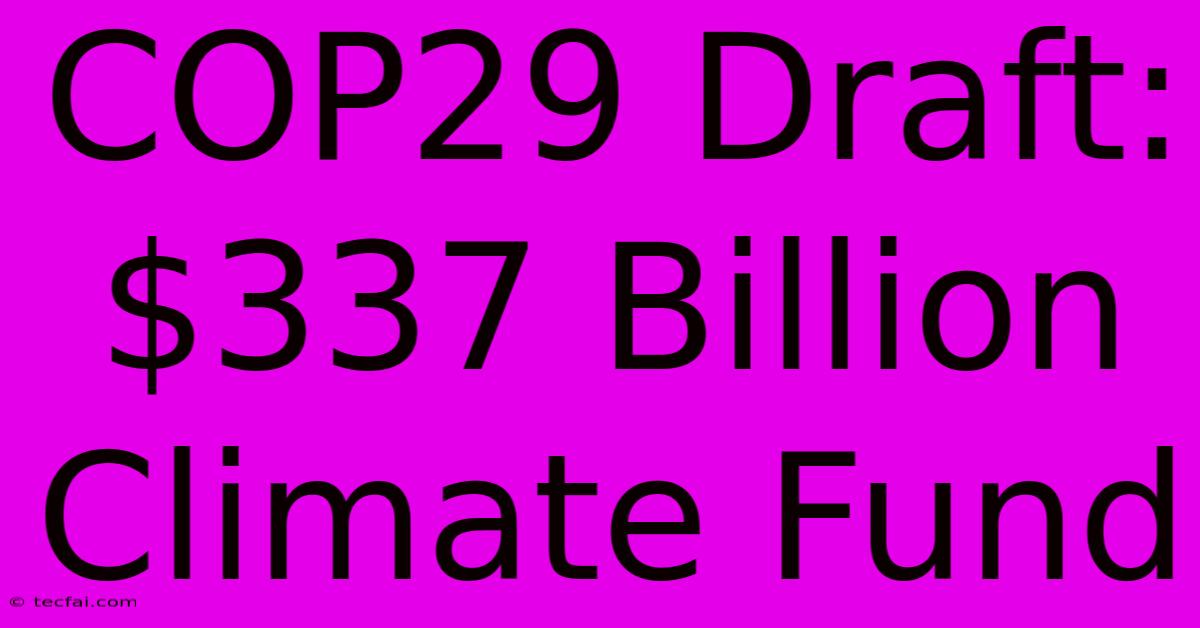COP29 Draft: $337 Billion Climate Fund

Discover more detailed and exciting information on our website. Click the link below to start your adventure: Visit Best Website tecfai.com. Don't miss out!
Table of Contents
COP29 Draft: A $337 Billion Climate Fund – Hope or Hype?
The COP29 draft proposal outlining a potential $337 billion climate fund has sent ripples through the global community. This monumental sum, earmarked for assisting developing nations in their climate change mitigation and adaptation efforts, represents a significant leap forward – or does it? This article delves into the details of this ambitious proposal, exploring its potential impact, the challenges it faces, and what it means for the future of climate action.
Decoding the $337 Billion Figure
The proposed $337 billion climate fund isn't a single, monolithic pot of money. Instead, it's a complex arrangement envisioned to be sourced from various contributors, including developed nations, multilateral institutions, and potentially the private sector. The allocation of funds is expected to be determined based on a nation's specific needs and vulnerabilities, prioritizing those most impacted by climate change while lacking the resources to effectively respond. This intricate distribution mechanism is crucial, requiring transparency and accountability to ensure equitable access and effective utilization.
Key Areas of Funding
The proposed fund is anticipated to address several crucial areas, including:
- Renewable Energy Transition: Significant funding will likely be channeled towards supporting the transition from fossil fuels to renewable energy sources in developing nations. This includes investments in solar, wind, geothermal, and other clean energy technologies, coupled with necessary infrastructure development.
- Climate Adaptation Measures: A substantial portion of the funds will be allocated to bolstering climate resilience. This encompasses initiatives like improved water management, drought-resistant agriculture, early warning systems for extreme weather events, and the strengthening of infrastructure to withstand climate-related impacts.
- Loss and Damage Compensation: This critical aspect addresses the irreversible consequences of climate change already being experienced by vulnerable communities. Funding in this area would support recovery efforts following extreme weather events, displacement due to sea-level rise, and other irreparable damages.
Challenges and Obstacles
While the sheer size of the proposed fund is inspiring, several significant challenges remain:
- Securing Funding Commitments: The biggest hurdle is obtaining concrete commitments from developed nations and other contributors. Negotiations will be intense, with countries potentially debating their fair share of the financial burden.
- Transparency and Accountability: Effective mechanisms for tracking and managing the vast sums of money are essential. Transparency in the allocation process and accountability for the use of funds are crucial to ensure the money reaches its intended beneficiaries and generates the desired impact.
- Implementation Capacity: Developing nations need the institutional capacity to effectively absorb and utilize these significant funds. Building the necessary administrative and technical expertise will be a key factor in the success of the climate fund.
- Political Will: Ultimately, the success of this initiative hinges on the political will of participating nations to commit to the fund and collaborate effectively in its implementation.
Hope for the Future?
The $337 billion climate fund proposal represents a bold ambition. While significant challenges lie ahead, its potential impact on global climate action cannot be understated. Its success depends on a concerted effort from all stakeholders – governments, international organizations, and the private sector – to overcome the hurdles and deliver on the promise of a more sustainable and equitable future. The coming months and years will be critical in determining whether this ambitious proposal transforms into tangible action, delivering real change to those most vulnerable to climate change. The details of implementation, the transparency of funding mechanisms, and ultimately, the level of international cooperation will determine the success of this unprecedented effort. Only time will tell if this is a beacon of hope or merely another fleeting promise.

Thank you for visiting our website wich cover about COP29 Draft: $337 Billion Climate Fund. We hope the information provided has been useful to you. Feel free to contact us if you have any questions or need further assistance. See you next time and dont miss to bookmark.
Featured Posts
-
Jfk Files Congress Takes Charge
Nov 23, 2024
-
Fx Market Summary November 20 2024
Nov 23, 2024
-
Listen Kendrick Lamars Gnx
Nov 23, 2024
-
Giants President On Jones
Nov 23, 2024
-
France Argentina Post Match Analysis And Insights
Nov 23, 2024
